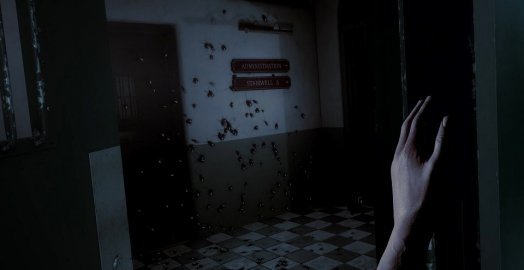Review for The Inpatient

Perhaps more than any other genre, horror seems tailor-made to experience in virtual reality. Having a love for all things scary, I eagerly anticipated The Inpatient’s release on PlayStation VR, awaiting the chance to plug in and be thrown into the dark, gloomy hallways of the Blackwood Sanatorium, an ideal setting for a terrifying experience if ever there was one. With Supermassive Games’ recent track record of narrative-based titles, and more specifically the frighteningly good time of their 2015 teen slasher franchise starter Until Dawn, I had every reason to be excited. Sometimes expectations can be dead wrong.
The Inpatient tells the story of what happened in the sanatorium sixty or so years before it played its role as a derelict set piece in Until Dawn. As such, this is a kind of pseudo-prequel, although it works as a standalone title and the two games are only tangentially connected through their settings and a few easter eggs. Unfortunately, this means that the game’s main draws for existing series fans – finding out what led to the clinic being shut down and the origin of the wendigos – aren’t really capitalized on. Main events take place off-screen, in distant rooms and holding cells in the asylum, with only faraway screams and shouts to serve as evidence of something horrible happening, and suddenly – presto! – now you’ve got monsters stalking the halls and grounds in scripted scare moments. The unnecessary “amnesiac patient” routine is equally wasted, failing to pay off in any meaningful way or satisfying moment of revelation.
To be fair, the opening minutes actually seem quite promising. The game begins as the player character, currently strapped to a chair in a dark operating room, is undergoing treatment to help him (or her, as you can choose your preferred gender and skin color) remember who he is. While it’s mildly disturbing to immediately find yourself the subject of experimentation, it’s only a momentary confinement, and before long a hospital orderly is pushing the still-immobile protagonist in a wheelchair to his cell.
You’ll become far too acquainted with your quarters, as a good third of The Inpatient’s three-or-so hour runtime is spent stuck there, at first alone, then later with a cellmate. Only intermittent dream sequences allow you to leave these confines and stalk the spooky dreamscape hallways, and here is where the game puts to good use the kind of disturbing potential it has. Shadowy figures beckoning from dimly-lit corridors, doors opening and closing on their own, nightmarish imagery, ghostly voices and sounds, and the odd jump scare pepper the clinic’s salons and morgues with literal hair-raising tension.
The initial stress brought on by VR immersion, with all real-life light completely blacked out by the helmet and headphones directly streaming the horror to my ears, is easily some of the realest I’ve ever felt during an interactive experience. The maddeningly slow walking pace you are forced to endure further stretches the thrill to its maximum limit. During select early moments, the urge to pull the headset off and assure myself of my benign actual surroundings grew pretty hard to ignore.
However, some of these same design choices started me on a downward spiral toward boredom elsewhere in the game. The dark lighting works wonders during moments of fear, but the scenes in your padded cell – the ones taking place in broad daylight – look similarly dim, filtered to really push the feeling of being in another time. Instead of mentally transporting you, though, it largely just results in making the otherwise detailed environments dull and uninteresting, a problem compounded by the general lack of interaction with your surroundings. The incessant palette of browns, blacks, and dark greens begins to overwhelm the original feeling of immersion with a crushing sense of depression. At first I wondered if I had somehow missed the option of adjusting the graphical settings, but I hadn’t – there aren’t any. The very few glimpses of natural lighting during flashback memories are little more than a tease, immediately replaced by the game’s standard washed-out and poorly lit visual aesthetic.
Likewise, the ponderously slow walking speed loses its appeal when taken out of context of the scary scenes. For one thing, having no other pace to choose from sooner or later undercuts the horror itself. Knowing that running from danger isn’t even an option makes it that much easier to resign oneself to what may come. The Inpatient isn’t a stealth game in which danger must be avoided, but rather more of a gallery of hallways to traverse, complete with unavoidable spooky sounds and pop-up scares.
The inability to escape danger also lessens its bite, since you eventually figure out that nothing can really harm you anyway. Being completely defenseless and incapable of avoiding peril would make for a very short and frustrating gaming experience if the monsters could truly impede your progress in any way. In fact, there’s nothing that gets in the way of slow and steady advancement toward the ultimate finish line – no puzzles, no combat or sections that require care and finesse, no dead ends caused by bungled decision-making. A few collectables are strewn about here and there, and a couple of characters can be interacted with, but there isn’t much to support a lot of satisfying gameplay.
Sadly, The Inpatient is not a case of sacrificing gameplay at the altar of storytelling either. Early scenes seem to promise a late-game payoff by asking questions about your identity and why you’re there. Fevered flashbacks and nightmarish dream scenarios raise the stakes, as an involving backstory definitely seems to have been the designers’ intention all along. However, these questions get almost entirely left by the wayside once the focus shifts from “stuck in a cell” to “escape the facility,” as neither you nor the surviving hospital staff have any idea of who you are, and nobody really cares in the face of blind survival. I’ve played the game two complete times and I still only have the vaguest grasp on the tale that was meant to be told before the requisite tie-in to Until Dawn’s narrative gets in the way.
The mix of one-part aimless pacing in a locked cell, two-parts following interminable hallways makes for an even duller replay, assuming you are interested in seeing some of the various outcomes and how decisions affect the unfolding story (pro tip: not much). The Inpatient uses the same “Butterfly” system seen in Until Dawn and Hidden Agenda, where even small choices could potentially have far-reaching consequences, leading to wildly different gameplay variants. Here, though, this system largely goes to waste. There are only a handful of actual Butterfly moments, and the repercussions are very understated. It’s not so much branching paths in the narrative as it is a few changed details along a very linear storyline.
The biggest differences between playthroughs concern which supporting characters live or die. But their fates don’t depend on a tangled web of choices and consequences, as one might think. Case in point: after my second time through, having seen two different endings already, I got curious what other ways the story could end. I jumped back in at the very last auto-save recorded, maybe 5-10 minutes before the credits rolled. Over the next 45 minutes or so, I played just that one little section, the very last scene, over and over, performing different actions at key moments, or even doing nothing at all, then advancing to the end, each time being rewarded with yet another new finale. So as it turns out, the outcome had less to do with how I’d behaved all along and much more with my actions during the closing moments. The three hours leading up to that point, on top of having grown quite stale even by the second time around, seemed to be pretty much irrelevant.
The Inpatient’s graphical presentation, an area in which its predecessors excelled, is a bit of a mixed bag this time. As nice as the indoor environments are, albeit drenched in unnatural sepia tones, there is an almost shocking lack of attention paid to the greater world at large sometimes, which seems a shame given the VR possibilities. The game uses its ever-present darkness and convenient plot devices like snow flurries as a means of omitting quite a bit of background detail. Even a cable car ride down the mountain is surrounded by utter darkness, flagrantly denying you a look at the scenery just outside the cabin’s windows.
One plus point continues to be the developer’s trend of highly detailed character models and facial animations, though there was something about the supporting cast that threw me for a loop, right from the beginning. At first I couldn’t put my finger on why the orderly during the opening scene bothered me, but eventually it hit me: several of the lifelike character models are reused transplants from the developer’s previous games. It is more than a little fourth-wall-breaking to be wheeled around a sanatorium by a Hidden Agenda crime scene analyst, or to see District Attorney Felicity Graves sporting an old-timey nurse’s uniform. Rather than being tongue-in-cheek cameos, these unrelated properties just seem haphazardly combined in a prequel where such connections are most likely to be noticed.
The industry trend toward more cinematic experiences is supported by the game’s audio design. Well done voice-over performances from the cast share the stage with an effective selection of licensed, period-appropriate tunes that play at certain moments. Silence is, of course, one of The Inpatient’s strong suits; combined with eerie sound effects and hair-raising jump scares, they comprise a great soundscape for having your pants scared off.
Using two PlayStation Move controllers, it’s possible to individually maneuver the character’s arms around, pulling the triggers to open and clench your hands to pick things up, while the buttons are used to move and turn. Getting a flashlight upon finally leaving your cell, one arm is always used to shine its beam around the environment. Often this is your only source of illumination, which does work well to infuse the game with more tension. Imagine frantically waving your flashlight beam around after hearing a sharp noise out of a dark corner, half-afraid of what’s hidden in the blackness, half-afraid of actually revealing it. With the camera’s built-in microphone, it’s possible to speak dialog options that appear on-screen rather than clicking the remote button to select them – an admittedly neat gimmick to lend the otherwise silent protagonist the most appropriate voice: yours.
Sadly, the VR aspect itself had moments where it seemed to struggle to keep up. Hand movements suffer from finicky controls, arms sometimes dragging along like dead weight or bending at unnatural angles. On one occasion, when the game forced my character into a seated position, one of my virtual arms got somehow caught under a virtual leg, making it impossible to detangle until the story was ready to let me stand up again. Unfortunately, it was the hand holding the flashlight, so the entire sequence played out in blackness, impossible to see.
The idea of slowly stalking the dark abandoned hallways of an insane asylum listening to monsters in the building’s hidden ducts and bowels sounds utterly terrifying, so it’s quite surprising how boring and yawn-inducing The Inpatient turns out to be. While it capitalizes on its VR immersion with early dream sequences full of chills, far too much time is spent in one confined location, and by the game’s halfway point the experience has been exposed as a one-trick pony, creepy nightmares giving way to tedious walking segment after tedious walking segment, with nothing more than meager interaction and the barest illusion of choice-driven narrative, at least until the end. Series newcomers can surely find better horror experiences to frighten them, and even Until Dawn fans are sure to be disappointed, as it fails to tell a coherent story despite the fact that we already know where it all leads anyway.
Our Verdict:
The Inpatient sounds amazing on paper, but the terror is watered down so quickly and to such a large degree that it manages to make three hours feel easily twice as long, and not in a good way.




























